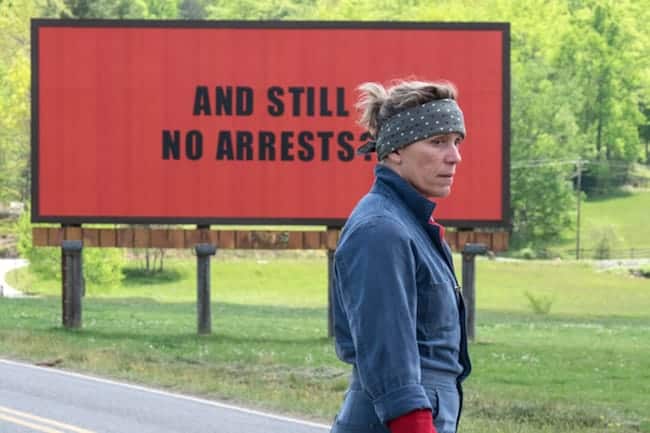
by Christina Waters | Feb 27, 2018 | Home |
Frances McDormand is certainly one of our finest actors. She is incapable of a mediocre or thoughtless performance. And in Three Billboards Outside Ebbing, Missouri she delivers with both barrels, an apt metaphor given the violence of the film.
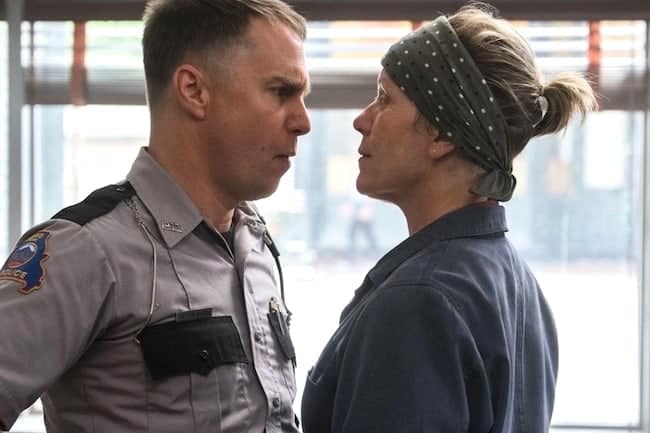
However, she was better in Fargo. She was better in Mississippi Burning. And while she creates an angry working class female hellbent on justice—the distaff equivalent of Charles Bronson’s angry working class male hellbent on justice—I found the character as written and directed by Martin McDonagh, to be a cheap stereotype relying upon expletives to convey depth of rage.
The overload of foul language struck me as way out of line. The point was made early on. We get it. These folks in Ebbing Missouri, from the racist cop Dickson (Sam Rockwell in an Oscar-winning performance) to the loving son of McDormand’s Mildred Hayes (played by Lucas Hedges) all spend a lot of time using the worst words in the Anglo-Saxon vocabulary. The very worst. But is it really necessary for the director to have them using these words in such quantities that we soon realize the F-word, the N-word, and the C-word are standing in for intelligently sculpted scenes of grief, poetic moments of emotion, and soaring diatribes of alienation and outrage?
I was shocked to hear the language a great actor like McDormand was required to spew simply to convince us that finally here was a feminist equivalent to an X-rated Lear.
McDonagh fails to realize this magic realist tale in other ways. It is inexcusably corny. The deer that comes to “visit” the grieving mother at one of the billboards. The scenes with her ex-husband and his new teenage girlfriend. Cinematic Thomas Kinkade. The voice-over we hear from Woody Harrelson’s deceased character, the cop with the heart of gold who dispenses bromides to various characters—redneck deus ex machina. A cheap trick.
Rockwell was pulverizing in a performance that seems to have divided critics and viewers. As the slow-witted, quick-fisted, racist cop who lives with his mom, he is an original creation, one that Rockwell inhabits like a tougher, younger Christian Bale. But there are those who now discredit his Oscar nomination simply because they deplore the character he portrays.
Hey! that’s why it’s called “make-believe.” It’s a movie. A cinematic fable, intended to shine light on the way we live in the real world. Don’t blame the messenger.
And yes, Frances McDormand will probably win the Oscar for her fearless performance.

Pre-Oscar Previews: the Good, the Bad, and the Best
by Christina Waters | Feb 27, 2018 | Home |
 The Good
The Good
I’d have to put Darkest Hour in the “Good” category although in retrospect it really is very very good. Two of the biggest reasons are: Gary Oldman and Winston Churchill. Oldman, in the role of any British actor’s dreams, has done it all (with the help of makeup artistry—he’s learned the speeches, the voice, and the physical gestures, and convinces us that we are actually watching the great and controversial statesman buck the odds, and Parliament, to resist surrendering to the powerful German army and Adolph Hitler.
All that cigar smoke, and the charm of Oldman as the charming Churchill, take us back for a moment into a time that called for heroic action, for courage, and a man who possessed both. A taut, crisp, never-boring, beautifully photographed slice of history. Oldman’s my choice for Best Actor award.
The Bad

Here The Shape of Water, with its manipulative political correctitude, barely edges out the meandering adult fairytale, a study in close-ups, that is Phantom Thread.
1950s London is the center of The high fashion house of dress designer Reynolds Woodcock (Daniel Day Lewis) is placed in 1950s London, where Woodcock, and his sister Cyril (Lesley Manville) dress royals and socialites with their opulent, yet austere creations. Woodcock has plenty of women, but remains a confirmed bachelor until he meets a fierce young working class woman, Alma (Vicky Krieps) who becomes his lover and muse. But not his throwaway plaything. Love is the curse of all artists, and soon Woodcock just cannot cope with the disruptions and distractions of life with Alma, a woman (we’re supposed to believe) that he truly loves. But Alma has plans of her own to subdue the moody dressmaker. Her method of control, of turning her master into her submissive sweetheart, is straight out of the Brothers Grimm. And yet it can’t inject interest, intrigue, or depth into this appropriately superficial study of close-up stitching, rich textile artisanship, and other stunning surfaces that add up to not a hell of a lot.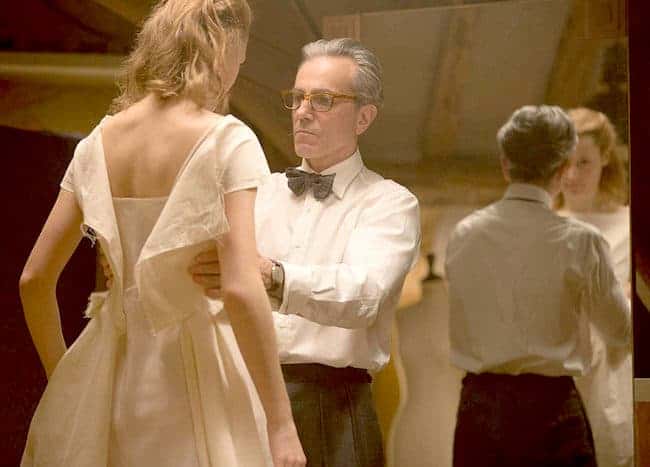
The only reading of this film that provides some possible gravitas to this latest collaboration between Daniel Day Lewis and director Paul Thomas Anderson (who directed Lewis to an Oscar in an equally perplexing film, There Will Be Blood) is one provided to me by a brilliant friend/cultural theorist in San Diego. She reads this film as a text on class confrontation. Alma represents the oppressed working class who finds a clever way to keep her elite lover/employer under her control. Perhaps. But for me, even that tantalizing analysis doesn’t make Phantom Thread into an engaging cinematic artwork.
My other caveat concerns the acting. Even though it sounds sacriligeous, Daniel Day Lewis is not at his best in this, his allegedly final film before he retires from the screen. He appears bored with the work, and scenes in which he and Krieps (who has the most glowing skin surface in cinema) are called upon to argue, fight, and confront each other appear to have been improvised. You can actually watch the two actors fumbling for adequate words of rage. They fail, and the scenes remain unconvincing.
The Best
I’ve got my money on Lady Bird, a tale that’s been told many times before—young girl coming of age, acting out, hates her hometown, feels her parents don’t understand her, wants to head for New york—but rarely this well. So spot on is the writing, directing, and acting that the actors on the screen are all but transparent. They stand back and let the characters reveal themselves. Seamless production in which we are convinced that we’re watching real people in real situations—situations that we’ve all been in: sexual experimentation that is anything but romantic or thrilling; falling for Mr. Wrong; slogging away at pointless jobs in a city far from anywhere; loving our friends more than our siblings; ditching our Real Best Friend for the school’s most popular girl only to find out that she’s a complete loser and our Real Best Friend is the Real Thing.
So good. Just incredibly right on. Dad played by Tracy Letts is the good cop, and mom, the incredibly Laurie Metcalf is the bad cop, in fact mom is the center of Lady Bird’s world, for better or worse.
If there’s any justice in this world—and we all know just how big an “if” that really is—the Oscar for Best Supporting Actress would go to Laurie Metcalf as the edgy, loving, stressed out, picky, nagging, perpetually disappointed mother. A great parent riddled with flaws, worry, and compassion.
Saoirse Ronan as Lady Bird McPherson is the essence of 18-year-old longing, intelligence, and spunk. Lucas Hedges, who made a huge impression in Manchester by the Sea, plays her first boyfriend, then friend, and Timothee Chalamet (Call Me by Your Name) plays a petulant Mr. Wrong, with a sparkling Beanie Feldstein as Lady Bird’s BFF.
The agony and the joy of being young is perfectly etched by director Greta Gerwig, and just possibly SHE will take the Oscar for Best Director.
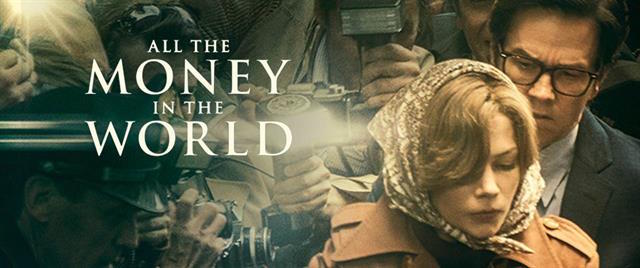
all the money in the world
by Christina Waters | Jan 19, 2018 | Home |
What went wrong here? I wondered as the credits rolled for All the Money in the World. A film made by Ridley Scott, former genius director, current recycler of old ideas, should have been at the least visually entertaining. A film starring Christopher Plummer as the insanely rich and greedy J. Paul Getty, should have offered some serious acting chops. Confession: Kevin Spacey would have been juicy and perfect in the role as the arch capitalist oil man. But you know why Spacey was replaced by Plummer, so that’s the end of that.
Even the always-charismatic Eternal City, Rome, couldn’t manage to inject interest into this languid (i.e. boring) revisitation of the infamous kidnapping of the Getty grand-son in the 70s. The 16 year old hippie (here played by Charlie Plummer) was abducted and held for $17 million ransom. The large sum was nothing compared to Getty the elder’s billions. But he refused to pay. Here’s where things should have quickened and gotten exciting. They didn’t.
In Scott’s curiously vacant hands the scenario just isn’t complex enough to hold 2 hours of cinema.
Also, the vocal work is distracting. I imagine this: Ridley Scott called up the widow of Heath Ledger (Michelle Williams), the always-reliable Mark Wahlberg and (ultimately) the 80something Christopher Plummer. Scott sat Williams and Plummer down in front of a screening of Roman Polanski’s Chinatown. “Study those accents,” he told the two leads, as they watched Faye Dunaway and John Huston.
If you close your eyes during the Ridley Scott film, you’ll hear Faye Dunaway (doing her Katherine Hepburn thing) and John Huston delivering their lines. It is an eerie deja vu.
Then there are the excessive Italian stereotypes, liberally employed to help us hate young Getty’s kidnappers. People in the audience groaned audibly—I was one of them—as the “Italians” fought, danced, drank, laughed, and acted like the shameless, outlaw peasants that they were.
Scott forgot how to edit. He forgot how to motivate actors, and when they did muster some dramatic tension, he forgot how to give his actors lines worth saying.
Even the great Plummer, shaking his head as he examines the day’s stock market numbers, only served to remind me of the great Orson Welles as another financial giant in Citizen Kane.
To paraphrase Lord Acton: money corrupts and all the money in the world, corrupts absolutely.
What a waste of time!
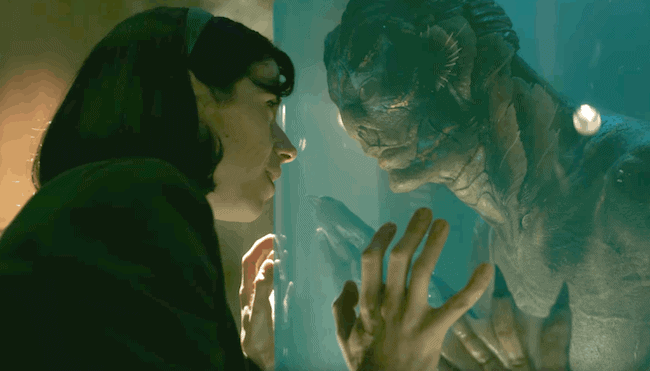
the Shape of Water
by Christina Waters | Jan 15, 2018 | Home |
Pity the poor critic who goes against the tide of public adulation. No one will thank me for not loving the heavy-handed fairy tale, The Shape of Water. No one will thank me for pointing out, against the tide if you will, that the filmmaker Guillermo del Toro, who crafted the uncanny Pan’s Labyrinth, has not repeated his success with this dark tale of forbidden love, cinema history, and diversity casting.
Short version: cross a Hallmark moment with early David Lynch—add scolding, didactic speeches and a minimalist approach to editing—and you get The Shape of Water, a showcase for characters of every gender, ethnicity, and economic background. Gently add a key disability—our heroine is mute—plus an Amazonian swamp creature (for that sexy dash of Otherness), and mix with Cold War clichés and a shocking amount of gratuitous gore and violence, and you either have a film to ride all the way to Oscar triumph…or a mess.
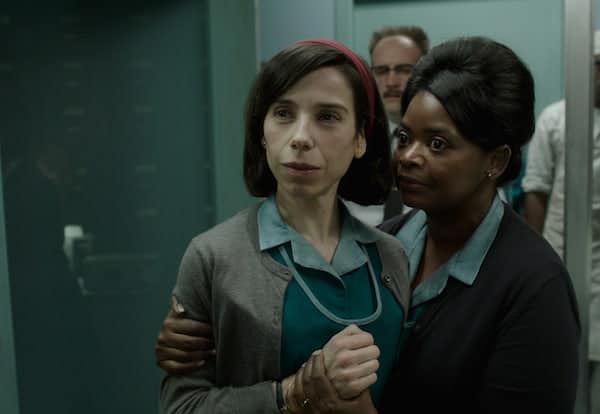
Sally Hawkins and Octavia Spencer in the film THE SHAPE OF WATER. Photo courtesy of Fox Searchlight Pictures. © 2017 Twentieth Century Fox Film Corporation All Rights Reserved
Oh how I wanted to fall in love with this film. So abundant in visual allure, such burnished color, and the irresistible crucible of forbidden love. But then why should it be forbidden? The filmmaker believes that he is not alone in treasuring the fantasy of a cross-species love. And he is not alone here. That much of the film tantalizes all of our tastebuds. It’s how he litters the trail with simplistic bread crumbs that makes, ultimately, for a flow chart of the wrong choices in this exercise in forking paths. (Sincere apologies to Borges.)
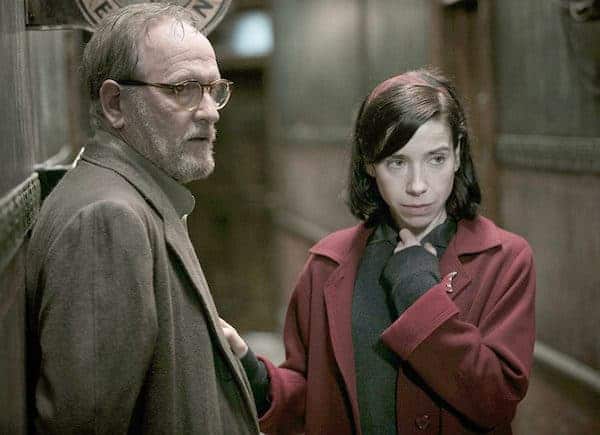 Magic realism, at its best, is a delicious elixir of visual and intellectual desire. But at its worst….let’s just say that at many crucial turns, the film implodes through its own lack of discipline. LIke a spoiled child with an expensive paintbox, del Toro indulges almost all of his fetishes whenever possible. His admirable championing of the oppressed becomes scolding and lecturing. His full rainbow of racial and gender operatives is so contrived and self-congratulatory as to grow tedious.
Magic realism, at its best, is a delicious elixir of visual and intellectual desire. But at its worst….let’s just say that at many crucial turns, the film implodes through its own lack of discipline. LIke a spoiled child with an expensive paintbox, del Toro indulges almost all of his fetishes whenever possible. His admirable championing of the oppressed becomes scolding and lecturing. His full rainbow of racial and gender operatives is so contrived and self-congratulatory as to grow tedious.
I get it: the Other is a real, living, breathing, loveable being with the same feelings, desires, and hopes that we all have. But del Toro works this obvious moral paradigm to death as if he had invented respect for diversity. I was alternately bored and insulted throughout this two hour exercise .
And then there’s the sobering realization that the film itself was growing tedious, just when all the stars have lined up to create a heartbreaking denouement. Speeches are all too long, except the ones that sling stereotypical soundbites like Marie Antoinette tossing cake to the masses.
You know the scenario by now: a loveless mute Eliza, who works nights as a cleaner in a top secret research facility, lives across the hall (above a fading movie palace) from aging, gay, artist Giles (Richard Jenkins). Eliza (Sally Hawkins) has a work buddy, Zelda (Octavia Spencer) with a heart of gold, tons of spunky attitude, and a layabout husband. (So many stereotypes!). Jenkins’ character is given to multiple, redundant soliloquies about the pitfalls of being an aging, gay artist. Yet del Toro has already shown us that well-worn situation quite clearly when Giles is thrown out of his favorite diner by the surly young owner he has a crush on.
 So much talk, talk, talk that could have become shining screen moments if only the lines, and the scenes, had been edited. Instead all the speeches are indulged, as are del Toro’s passion for the golden age of television (Dobey Gillis) and the Busby Berkeley era.
So much talk, talk, talk that could have become shining screen moments if only the lines, and the scenes, had been edited. Instead all the speeches are indulged, as are del Toro’s passion for the golden age of television (Dobey Gillis) and the Busby Berkeley era.
Sally Hawkins is wonderfully watcheable, yet her character doesn’t expand into our hearts. Ditto her work buddy Octavia Spencer who is forced to embody almost every black cleaning woman cliché that has ever seen the light of cinema. Shameless exploitation of the worst cultural models of working women, women of color, people of alternative genders, disabilities, and financial straits—all of this surrounds a central fable in which the ultimate Other is accepted by, and accepts, the yearning Eliza. How lovely this might have been had it not insulted the viewer with its elementary school lesson plan. See? the director says to us slowly and patiently, see how nicely we could all get along?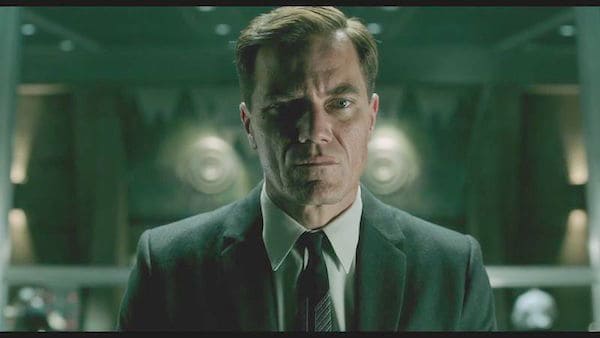
Two opposing male sexual forces drive the dramatic tension of The Shape of Water. One is the sadistic boss of the research operation—which takes place during the Cold War, hence acres of paranoia and lengthy spy meetings held in Russian. This character, Strickland, played with merciless roughness by Michael Shannon, somehow stands in for the callous, predatory American male of the 1940-50s. Del Toro unleashes him to commit sudden acts of violence—verbal, psychological, and finally physical. Especially toward the amphibious creature, kept chained in a tank of water, that Eliza begins to befriend, and then fall in love with. As sweet as Strickland is harsh, the Creature attracts Eliza, as they glide into an entrancing relationship that quickens when Strickland orders “it” killed for dissection.
Shannon is a powerhouse, as Strickland, and Strickland is a mesmerizing character, but one required to talk and pose, ponder and extol. We tire of him and his violence, long before he can ignite the finale. And the inter-plot, featuring a Russian spy who works at the research facility, and his various spy masters, bogs down rather than adding texture. Del Toro stoops to just about everything, from suburban sex and gangrenous hands, to endless quotes from 50s television. And even—shades of The Artist —the fairytale lovers at one point morph into silver screen performers, twirling and singing their way through a Fred & Gingeresque version of “You’ll Never Know.”
Instead of telling one adult fairytale of true, if magical, love del Toro decided to tell lots of stories all at once. We the audience must choose which strands taste best, and devour them if we want to leave the theater with appetites satisfied. I left hungry.
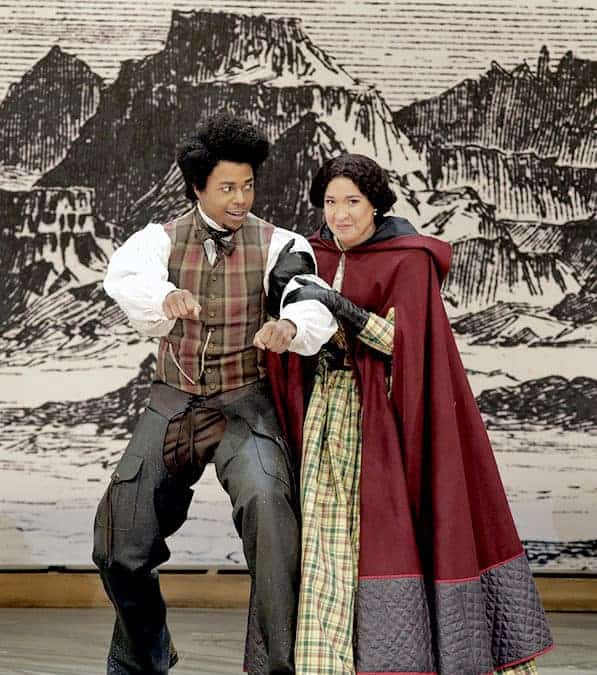
Fool’s Gold
by Christina Waters | Dec 12, 2017 | Home |
It seemed like a good idea at the time. Composer John Adams and his librettist Peter Sellars immersed themselves in the vivid letters of a New England doctor’s wife who wrote about what she observed in the gold mining camps of the 1850s Sierras. She found colorful men and women, women whose influence was clever and fast and tragic out there in the Wild West. Why not build an opera around the gritty true stories of some plucky women whose fates and fortunes were thus far unknown? The saloon dancers, Mexican camp followers, Asian prostitutes, the girls of the golden west.
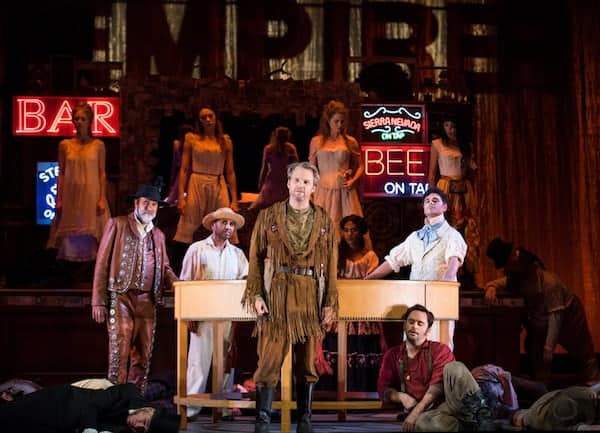
Somewhere between inspiration and delivery, alas, the pungent observations of the doctor’s wife, who wrote under the pen name Dame Shirley, went awry. So much material, so few rewards. Mining for a heart of gold, the collaborators of Girls turned up mostly iron pyrite.
Occasionally, peeking out here and there from the thundering cacophany of orchestral syncopation and urgency, there were flashes of the soaring lines and engaging rhapsodies of the John Adams we know from Nixon in China and Doctor Atomic. But such moments were rare and required sitting through the over-long, under-developed arch of what remained just an idea without artistic development.
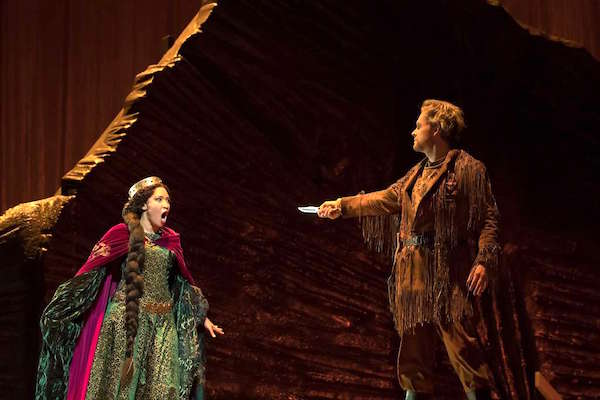 Sellars, who clearly put little energy or invention into the libretto, seemed content to clip out passages from Dame Shirley’s dispatches and have the singers essentially read them to us. Breaking the most elementary rule of theater, Sellars failed to show us the dramas being told. Even with the entire stage of the opera house he found it impossible to show us any dramatic involvement. The opera is devoid of dramatic tension [an exception, shown above, is a ravishing bit of miner’s camp Shakespeare in the form of scenes from Macbeth.] and reveals precious little in the way of actual engagement between characters. Singers came on, they sang words, the orchestra hurled itself through excruciatingly difficult rhythmic passages and then the giant stump that served as the main showcase was pushed a few feet to the left. And then a few feet back to the right.
Sellars, who clearly put little energy or invention into the libretto, seemed content to clip out passages from Dame Shirley’s dispatches and have the singers essentially read them to us. Breaking the most elementary rule of theater, Sellars failed to show us the dramas being told. Even with the entire stage of the opera house he found it impossible to show us any dramatic involvement. The opera is devoid of dramatic tension [an exception, shown above, is a ravishing bit of miner’s camp Shakespeare in the form of scenes from Macbeth.] and reveals precious little in the way of actual engagement between characters. Singers came on, they sang words, the orchestra hurled itself through excruciatingly difficult rhythmic passages and then the giant stump that served as the main showcase was pushed a few feet to the left. And then a few feet back to the right.
Rarely in the annals of opera history has so little been done with so little.
Throughout the set changes, i.e. moving the giant, ugly stump back and forth across the stage, four poor forlorn young women were positioned to either dance, strut, kick, or push a brass bed around in circles. Given no stage direction and only rudimentary choreography, their Greek chorus had all the narrative power of a junior varsity pep rally. Like much of the indecipherable staging, such moments of mining camp hijinks were frankly embarrassing.
Blatantly ugly set “design”—so minimalist as to defy basic Theater 101 strategies—was matched by unappealing costuming, and ludicrous stage direction — again by Sellars, who insisted on the tedious and distracting “open wings” agenda. Somehow the formerly gifted collaborator had forgotten everything he knew about how human beings stand, sit, walk, and become interested in each other.
The Good News
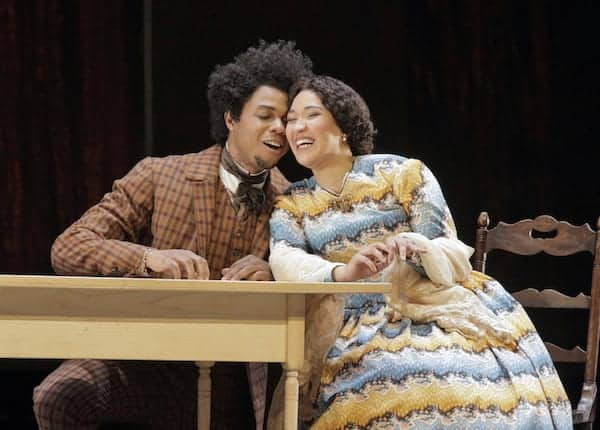 The final performance of this world premiere yielded some gorgeous singing by a vibrant young cast, powered by Adams’ beautiful arias for solo voices, soaring through the inane campfire mayhem and barroom boister.
The final performance of this world premiere yielded some gorgeous singing by a vibrant young cast, powered by Adams’ beautiful arias for solo voices, soaring through the inane campfire mayhem and barroom boister.
As Ned Banks, the freed slave companion of Dame Shirley, Davone Tines [above] was a sorcerer of physical invention and supple bass-baritone vocal power. The stage came to life every time he stepped, danced, and twirled onto it. He transformed Adams’ haunting piece based upon Frederick Douglass’ speech “What to a Slave is the Fourth of July?” into a moment of breathtaking clarity. Tines—destined for stardom—gathered together words and music with as much magic as Adams’ deeply affecting Doctor Atomic aria, “Batter my heart, three-person’d God.”
Why then was he “killed off” two-thirds of the way through the opera? Worse—we are only told that he was killed somewhere off-stage, an event that cried out for dramatization. Another rule broken: you never kill off your most popular character before the end. Once Tines was gone, the opera slowed and meandered. 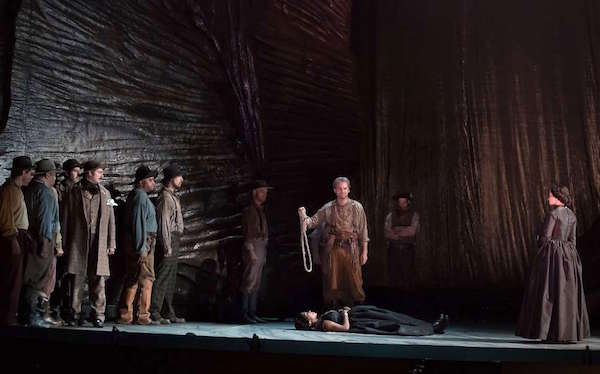
Another aria, for Josefa, a beautiful Mexican woman destined for the gallows, was sung in Spanish and English by J’Nai Bridges, whose lustrous voice gave elegance and dignity to the superbly surrealist aria Adams created for her.
 In other notable performances, Paul Appleby as luckless miner Joe Cannon brought a clarion tenor voice and persuasive acting to his on-stage antics. As another rabble-rousing miner bass Ryan McKinny offered searing moments of vocal beauty and angst. (McKinny already has at least one Wagner role under his belt, and it would be revelatory to hear Tines as Wotan one of these years.) As the raw-boned denizens of the camps, the SF Opera chorus men attacked the repetitive, Glassian declamations with appropriate bravado.
In other notable performances, Paul Appleby as luckless miner Joe Cannon brought a clarion tenor voice and persuasive acting to his on-stage antics. As another rabble-rousing miner bass Ryan McKinny offered searing moments of vocal beauty and angst. (McKinny already has at least one Wagner role under his belt, and it would be revelatory to hear Tines as Wotan one of these years.) As the raw-boned denizens of the camps, the SF Opera chorus men attacked the repetitive, Glassian declamations with appropriate bravado.
The hero of Girls of the Golden West must be the splendid and commanding Julia Bullock, making her San Francisco Opera debut as Dame Shirley (Bullock offered us the witty turnabout of an African-American performer cast as a white woman). Adams gave her some of his finest work in the gossamer opening passages as the she discovers the craziness of California, and at the very end (way too long in the making) in which she proclaims the indelible beauty of the land, transcending its raw, violent male culture.
It’s possible that there is an opera somewhere in all these many ideas—one that brings to robust and emotionally-charged life the rough world of the 19th century mining camps. But Girls of the Golden West is not yet that opera.

The Ring in Vienna
by Christina Waters | Oct 24, 2017 | Home |
Three days after the last rolling waves of the Rhine river had dissolved into thin air, the music stayed inside my body. All of the themes of Richard Wagner’s opulent masterpiece resound. They’ve seeped into me through the surge and flow of the four operas that sum up his epic vision of greed, love, power, the gods, and humanity itself. I can still hear the Rhine maidens tempting the evil dwarf Alberich, and feel the sparks and flint of his anvil forging the gold into instruments of malecious magic. The much-parodied, still overwhelming theme of Brunnhilde and her Valkyries, the sad majesty of Wotan, doomed lord of the ring and father of the gods. Siegfried‘s horn, the dragon Fafner‘s thundering mischief, the sparkling flicker of Loge, the god of fire. With luck, the music will stay and sing to me for another few weeks, until it gradually releases me from its spell.
The music not only powers the great mythology of Wagner’s Ring, the music is the saga itself. At least in the hands of maestro Peter Schneider and the consummate orchestra of the Vienna State Opera I heard this summer. Performing on the exact instruments Wagner specified,( and in the case of the Wagner horn, whose sound resembles a cross between a trumpet and a trombone, an instrument Wagner himself designed) this orchestra created the sonic bridge that took last May’s audience from the 19th century hall to the edge of Valhalla itself.
But the orchestra had help. A solid cast of singers—notably a wickedly affecting Wotan (Tomasz Konieczny), a marathon heldentenor Stefan Vincke as Siegfried, an occasionally breathtaking Petra Lang as Brunnhilde as well as two marvelous villains in the form of Ain Anger as Hundig and Falk Struckman as Hagen.
It’s a rare and costly enterprise to commit to a cycle of The Ring’s four operas—”four long operas” —in this case involving a stretch of 10 days and 16+ hours of onstage performance. To explain to a Wagner virgin that you are actually going to submit to that many hours of sitting, listening, and watching is to sound off one’s rocker. But to Wagnerites, this endurance contest is life-giving.
Once you’ve heard all four operas in close proximity, e.g. Seattle and Bayreuth perform the four operas over a brisk seven day period, you are changed forever. Each individual opera forms a poetic whole and yet points onward to the next one. The final piece, Gotterdammerung, revives all of the musical gestures, emotions, and motifs of the previous works. It both concludes—as only the destruction of Vallhalla can—and yet it lives on within the viewer. The Valhalla theme—a triumphant bolero—is a glorious, and yes, catchy motif. Less than a day after the final French horn had sounded, I was planning my next “Ring.” It is a journey in which there is no conclusion, there is only endless transformation.[below: Tomas Konieczny as Wotan.]
 Wagner’s Ring amounts to a theatrical version of the pilgrimage to Santiago de Compostela. We are all pilgrims, journeying through the voices, the stagecraft, the soaring instrumentation, the multi-dimensional myth, en route to a holy shrine. And yet the route in this case is the shrine, and every note is a sacrament.
Wagner’s Ring amounts to a theatrical version of the pilgrimage to Santiago de Compostela. We are all pilgrims, journeying through the voices, the stagecraft, the soaring instrumentation, the multi-dimensional myth, en route to a holy shrine. And yet the route in this case is the shrine, and every note is a sacrament.
Back to the performance. The opera as a complete work of music-theater belongs, as it must, to Wagner. He gives us a morality play disguised as a fairytale (Rheingold & Walküre). Much of the libretto makes no sense, but once the very first long measures of Rheingold begin, we simply don’t care. It is all about the music! A glorious orchestra, each section—strings, brass, harp—better than the next, dove deeply into the mind of Wagner and emerged with a steady outpouring of ecstatic darkness, shimmering topnotes, plush chromaticism powered by unerring virtuosity. The musicians seemed connected to both the conductor and the singers by an organic web. Utterly convincing. So perfect were the upward movements, the crescendoes, that even the high notes of trumpets seemed made of new colors.
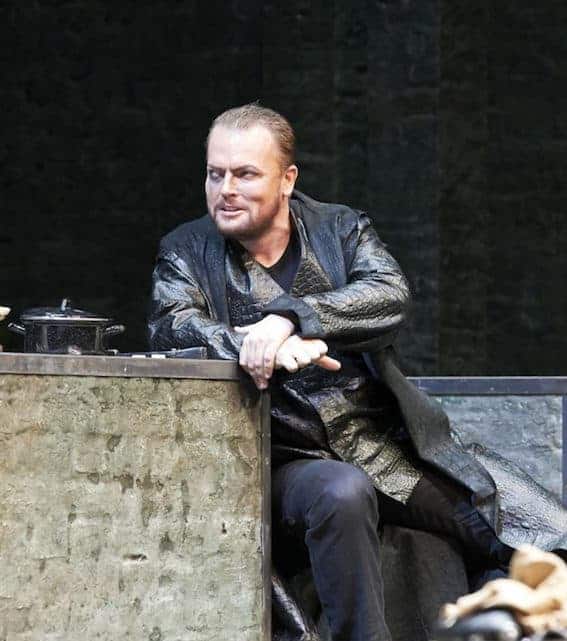 Some specifics about this Vienna Staatsopera 2017 production, reviving minimalist but effective staging and sets by Sven-Eric Bechtolf. Small details brought this Ring to moments of great clarity and resonance.In Rheingold, as Wotan fights for possession of the gold ring with the Niebelung Alberich, (Jochen Schmeckenbecher) the stagecraft shows us the two mythical opposites—king of the Gods, and underground-dwelling dwarf—joined by a single crimson cord. Their tug-of-war visually reminds us of how they are united in their greed, and whoever wins the gold, will lose it in the end. That single red cord, the width of the entire stage, was arrestingly eloquent of the Nietzschean tension in these opposing characters.
Some specifics about this Vienna Staatsopera 2017 production, reviving minimalist but effective staging and sets by Sven-Eric Bechtolf. Small details brought this Ring to moments of great clarity and resonance.In Rheingold, as Wotan fights for possession of the gold ring with the Niebelung Alberich, (Jochen Schmeckenbecher) the stagecraft shows us the two mythical opposites—king of the Gods, and underground-dwelling dwarf—joined by a single crimson cord. Their tug-of-war visually reminds us of how they are united in their greed, and whoever wins the gold, will lose it in the end. That single red cord, the width of the entire stage, was arrestingly eloquent of the Nietzschean tension in these opposing characters.
Ironically, I had gone to Vienna specifically to hear the great Welsh baritone Bryn Terfel sing Wotan. He cancelled at the very last minute, and Konieczny stepped in. It turned out to be a great act of fate. Konieczny is not only an attractive and dynamic stage presence, but his honeyed voice lent endless color variations to Wagner’s innovative passages powering Wotan’s existential struggles. A tremendously effective actor, Konieczny’s farewell to his daughter Brunnhilde had the audience in tears. Never before had I grasped the depth of this father’s pain upon releasing his much-loved daughter of her immortal status. In her shameful mortality, we glimpse the beginning of the end. It was a scene I will never forget.
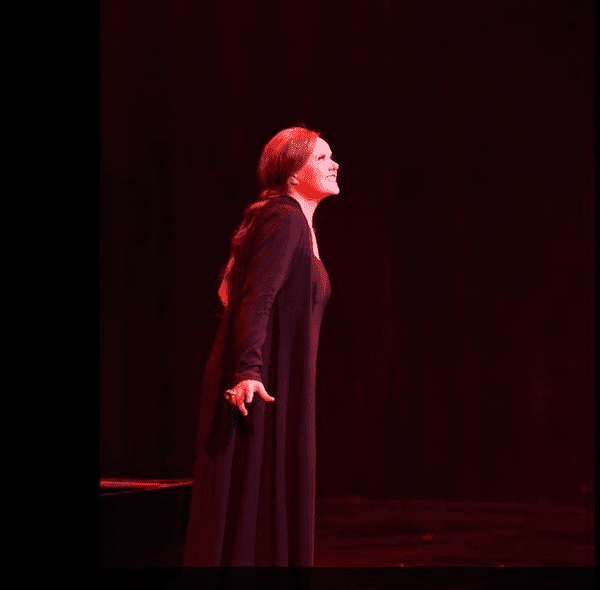
Götterdammerung, the last and longest (6 hours, including two intermissions), did not disappoint. Petra Lang dropped her annoying physical mannerisms—the petulant facial mannerisms, the clenched fists—and stepped confidently into the persona of the mythic Valkyrie, Wotan’s favorite daughter, and became the beloved wife of fallen hero Siegfried. She was magnificent, her voice strong, soaring, often beautiful in its burnished and rich mid-tones. As she sang farewell to her father, and to his dreams of an immortal Valhalla for all the heroes, she was both bitter and heartbroken. Be at peace, she sings to her absent father. Ruhe, o gott—Rest, oh god. In the end, I was convinced by Lang, a brilliant if not charismatic Brunnhilde.
Her Brunnhilde is Adam, disobeying God and paying the price: the loss of Eden, loss of heaven, loss of immortality. Yet she gained the ability to love, something that Wotan sacrificed in order to possess the ring. While Stefan Vincke’s Siegfried had vocal stamina to burn, his tendency to grin inappropriately (perhaps he thought he was playing Parsifal?) robbed many key moments of their power.
Wagner’s Ring is a sacred journey that binds all those who travel it in a deathless fellowship. A fellowship of the ring. The music continually makes us an offer we cannot refuse.
Months later, I am still filled with the power of Wagner’s music—an incomparable achievement in artistic vision. Bravo to the magnificent Vienna Philharmonic orchestra, whose empassioned expertise reforged this Ring with elegance and power.












 Magic realism, at its best, is a delicious elixir of visual and intellectual desire. But at its worst….let’s just say that at many crucial turns, the film implodes through its own lack of discipline. LIke a spoiled child with an expensive paintbox, del Toro indulges almost all of his fetishes whenever possible. His admirable championing of the oppressed becomes scolding and lecturing. His full rainbow of racial and gender operatives is so contrived and self-congratulatory as to grow tedious.
Magic realism, at its best, is a delicious elixir of visual and intellectual desire. But at its worst….let’s just say that at many crucial turns, the film implodes through its own lack of discipline. LIke a spoiled child with an expensive paintbox, del Toro indulges almost all of his fetishes whenever possible. His admirable championing of the oppressed becomes scolding and lecturing. His full rainbow of racial and gender operatives is so contrived and self-congratulatory as to grow tedious. So much talk, talk, talk that could have become shining screen moments if only the lines, and the scenes, had been edited. Instead all the speeches are indulged, as are del Toro’s passion for the golden age of television (Dobey Gillis) and the Busby Berkeley era.
So much talk, talk, talk that could have become shining screen moments if only the lines, and the scenes, had been edited. Instead all the speeches are indulged, as are del Toro’s passion for the golden age of television (Dobey Gillis) and the Busby Berkeley era.


 Sellars, who clearly put little energy or invention into the libretto, seemed content to clip out passages from Dame Shirley’s dispatches and have the singers essentially read them to us. Breaking the most elementary rule of theater, Sellars failed to show us the dramas being told. Even with the entire stage of the opera house he found it impossible to show us any dramatic involvement. The opera is devoid of dramatic tension [an exception, shown above, is a ravishing bit of miner’s camp Shakespeare in the form of scenes from Macbeth.] and reveals precious little in the way of actual engagement between characters. Singers came on, they sang words, the orchestra hurled itself through excruciatingly difficult rhythmic passages and then the giant stump that served as the main showcase was pushed a few feet to the left. And then a few feet back to the right.
Sellars, who clearly put little energy or invention into the libretto, seemed content to clip out passages from Dame Shirley’s dispatches and have the singers essentially read them to us. Breaking the most elementary rule of theater, Sellars failed to show us the dramas being told. Even with the entire stage of the opera house he found it impossible to show us any dramatic involvement. The opera is devoid of dramatic tension [an exception, shown above, is a ravishing bit of miner’s camp Shakespeare in the form of scenes from Macbeth.] and reveals precious little in the way of actual engagement between characters. Singers came on, they sang words, the orchestra hurled itself through excruciatingly difficult rhythmic passages and then the giant stump that served as the main showcase was pushed a few feet to the left. And then a few feet back to the right. The final performance of this world premiere yielded some gorgeous singing by a vibrant young cast, powered by Adams’ beautiful arias for solo voices, soaring through the inane campfire mayhem and barroom boister.
The final performance of this world premiere yielded some gorgeous singing by a vibrant young cast, powered by Adams’ beautiful arias for solo voices, soaring through the inane campfire mayhem and barroom boister.
 In other notable performances, Paul Appleby as luckless miner Joe Cannon brought a clarion tenor voice and persuasive acting to his on-stage antics. As another rabble-rousing miner bass Ryan McKinny offered searing moments of vocal beauty and angst. (McKinny already has at least one Wagner role under his belt, and it would be revelatory to hear Tines as Wotan one of these years.) As the raw-boned denizens of the camps, the SF Opera chorus men attacked the repetitive, Glassian declamations with appropriate bravado.
In other notable performances, Paul Appleby as luckless miner Joe Cannon brought a clarion tenor voice and persuasive acting to his on-stage antics. As another rabble-rousing miner bass Ryan McKinny offered searing moments of vocal beauty and angst. (McKinny already has at least one Wagner role under his belt, and it would be revelatory to hear Tines as Wotan one of these years.) As the raw-boned denizens of the camps, the SF Opera chorus men attacked the repetitive, Glassian declamations with appropriate bravado.

 Wagner’s Ring amounts to a theatrical version of the pilgrimage to Santiago de Compostela. We are all pilgrims, journeying through the voices, the stagecraft, the soaring instrumentation, the multi-dimensional myth, en route to a holy shrine. And yet the route in this case is the shrine, and every note is a sacrament.
Wagner’s Ring amounts to a theatrical version of the pilgrimage to Santiago de Compostela. We are all pilgrims, journeying through the voices, the stagecraft, the soaring instrumentation, the multi-dimensional myth, en route to a holy shrine. And yet the route in this case is the shrine, and every note is a sacrament. Some specifics about this Vienna Staatsopera 2017 production, reviving minimalist but effective staging and sets by Sven-Eric Bechtolf. Small details brought this Ring to moments of great clarity and resonance.In Rheingold, as Wotan fights for possession of the gold ring with the Niebelung Alberich, (Jochen Schmeckenbecher) the stagecraft shows us the two mythical opposites—king of the Gods, and underground-dwelling dwarf—joined by a single crimson cord. Their tug-of-war visually reminds us of how they are united in their greed, and whoever wins the gold, will lose it in the end. That single red cord, the width of the entire stage, was arrestingly eloquent of the Nietzschean tension in these opposing characters.
Some specifics about this Vienna Staatsopera 2017 production, reviving minimalist but effective staging and sets by Sven-Eric Bechtolf. Small details brought this Ring to moments of great clarity and resonance.In Rheingold, as Wotan fights for possession of the gold ring with the Niebelung Alberich, (Jochen Schmeckenbecher) the stagecraft shows us the two mythical opposites—king of the Gods, and underground-dwelling dwarf—joined by a single crimson cord. Their tug-of-war visually reminds us of how they are united in their greed, and whoever wins the gold, will lose it in the end. That single red cord, the width of the entire stage, was arrestingly eloquent of the Nietzschean tension in these opposing characters.
